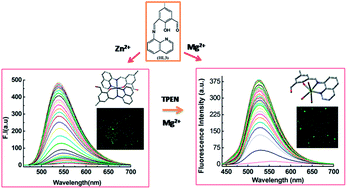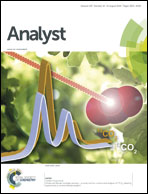A novel chromo- and fluorogenic dual sensor for Mg2+ and Zn2+ with cell imaging possibilities and DFT studies†
Abstract
A diformyl-p-cresol (DFC)-8-aminoquinoline based dual signaling probe was found to exhibit colorimetric and fluorogenic properties on selective binding towards Mg2+ and Zn2+. Turn-on fluorescent enhancements (FE) as high as 40 fold and 53 fold in 9 : 1 MeCN/water (v/v) at pH 7.2 in HEPES buffer for Mg2+ and Zn2+, respectively, were observed. The binding constants determined from the fluorescence titration data are: K = (1.52 ± 0.21) × 105 M−1 and (9.34 ± 4.0) × 103 M−2 at n = 1 and 0.5, for Mg2+ and Zn2+, respectively. The L : M binding ratios were also determined by Job's method, which support the above findings. This is further substantiated by HRMS analysis. Due to solubility in mixed organo-aqueous solvents as well as cell permeability it could be used for the in vitro/in vivo cell imaging of Mg2+ and Zn2+ ions with no or negligible cytotoxicity. This probe could be made selective towards Mg2+ over Zn2+ in the presence of TPEN, both under intra- and extracellular conditions and is superior to other Mg2+ probes which suffer from selectivity of Mg2+ over Ca2+ or Zn2+. Furthermore the dissociation constant (Kd = 6.60 μM) of the Mg2+-(DFC-8-AQ) complex is far lower than the so far reported Mg2+ probes which fall in the mM range.


 Please wait while we load your content...
Please wait while we load your content...